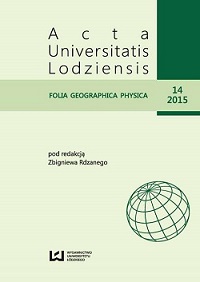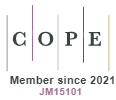DEM-based reconstruction of historical earth’s surface of areas before antropogenic transformation: selected examples from Central Poland
DOI:
https://doi.org/10.18778/1427-9711.14.02Keywords:
Digital Elevation Model, comparing terrain models, historical DEM, GIS analysesAbstract
The article is a presentation of the process leading to the creation of a terrain model of selected areas in Central Poland before anthropogenic transformations which took place half a century ago. The aim of this study was to reconstruction Digital Elevation Models (called DEM) of the area, which is not currently available for research using modern methods of gathering altitude information due to anthropogenic transformation. The work shows the exact criteria for the selection of source materials along with an indication of the frame of reference date of the map and contour line distance. The main part of the article presents two examples – the largest complex of open mining and energy sector in Europe – KWB Bełchatów and Sulejów Reservoir as a water reservoir for the biggest city of Central Poland – Łódź – a detailed description of the methodology for dealing with historical maps, and the course of work from the selection of appropriate maps, through their scanning, calibration and vectorization to the final result, which is to obtain a terrain model, treated as a historical one. This study highlights the advisability of such activities and the use of DEM models in practice and in the analysis of directions and scale of anthropogenic transformations of historic and contemporary relief.
Downloads
References
Badura, J., Przybylski, B., 2005. Application of digital elevation models to geological and geomorphological studies – some examples. Przegląd Geologiczny 53(10/2), 977–983.
Google Scholar
Ewertowski, M., Tomczyk, A., 2007. Numeryczny Model Terenu i jego pochodne dla recesyjnych form młodoglaclalnych na obszarze Wielkopolski, [w:] Smolska E., Giriat D. (red.), Rekonstrukcja dynamiki procesów geomorfologicznych – formy rzeźby i osady. Uniwersytet Warszawski, Warszawa, 141–150.
Google Scholar
IMGW 2008. Zbiornik wodny Sulejów badania sedymentacji i aktualizacja pojemności.
Google Scholar
James, L.A., Hodgson, M.E., Ghoshal, S., Latiolais, M., 2012. Geomorphic change detection using historic maps and DEM differencing: The temporal dimension of geospatial analysis. Geomorphology 137, 181–198.
Google Scholar
DOI: https://doi.org/10.1016/j.geomorph.2010.10.039
Jaskulski, M., Łukasiewicz, G., Nalej, M., 2013. Porównanie metod transformacji map historycznych (Comparison of methods for historical map transformation). Roczniki Geomatyki 11, 4(61), 41–58 http://rg.ptip.org.pl/index.php/rg/article/view/RG2013- 4-JaskulskiLukasiewiczNalej
Google Scholar
Jaskulski, M., Szmidt, A., 2013. Ocena przydatności automatycznego wyznaczania linii szkieletowych terenu do analiz geomorfometrycznych. Acta Universitatis Lodziensis, Folia Geographica Socio-Oeconomica 14, 145–156. URI: 11089/10772.
Google Scholar
Jaskulski, M., Szmidt, A., 2014. Transformations in morphometry of valley bottom as e result of the creation of artificial water reservoir on tne example of Sulejowskie Lake in the Light of the Chosen GIS Mathods. IGU 2014 Book of Abstracts IGU – 0524.
Google Scholar
Jaskulski, M., Szmidt, A., 2015. Transformations in morphometry of valley bottom as a result of the creation of a reservoir illustrated with the example of Sulejów Lake. Landform Analysis 27, 15–21 (w druku).
Google Scholar
DOI: https://doi.org/10.12657/landfana.027.002
Medyńska-Gulij, B., 2010. Perspektywa na mapach – konfrontacja metod prezentacji rzeźby terenu z wizualizacjami 3D, [w:] Żyszkowska, W., Spallek, W. (red.), Numerycznie modele w kartografii. Wrocław, 14–21.
Google Scholar
Mitka, B., Piech, I., 2012. Modelowanie powierzchni terenu. Infrastruktura i ekologia terenów wiejskich 3/I/2012, PAN, 167–180.
Google Scholar
Molewski, P., Juśkiewicz, W., 2014. Próba rekonstrukcji pierwotnej rzeźby obszaru Zespołu Staromiejskiego w Toruniu i jego bliskich przedmieść na podstawie geoinformacji geologicznej i historycznej. Landform Analysis 25, 115–124. DOI: 10.12657/landfana.025.010.
Google Scholar
DOI: https://doi.org/10.12657/landfana.025.010
Nowak, T., 2015. Rzeźba terenu z okresu przedinwestycyjnego na obszarze KWB Bełchatów na podstawie Numerycznego Modelu Terenu. Maszynopis pracy magisterskiej, Katedra Geografii Fizycznej UŁ.
Google Scholar
Sibson, R., 1981. A brief description of natural neighbor interpolation, [w:] Barnett, V., Interpreting Multivariate Data, Wydawnictwo John Wiley & Sons, Nowy Jork, USA, 21–36.
Google Scholar
Szubert, M., 2008. Geomatyka w badaniach geomorfologicznych. Dokumentacja Geograficzna 37, 7–13.
Google Scholar
Viesmann, S., Brüngger, A., Schenkel, R., Sidler, A., Hurni, L., 2013. Historical Maps as Source for Glacier DEM Reconstruction Mapping Mountain Dynamics: From Glaciers to Volcanoes New Zeland.
Google Scholar
Wałek, G., 2013. Wykorzystanie programów QuantumGIS i SAGA GIS do budowy cyfrowego modelu wysokościowego zlewni Grajcarka. Acta Universitatis Lodziensis, Folia Geographica Socio-Oeconomica 14, 133–144. URI: 11089/10745.
Google Scholar
Zasadni, J., Kłapyta, P., 2014.The Tatra Mountains during the Last Glacial Maximum. Journal of Maps, 1–17. DOI: 10.1080/17445647.2014.885854.
Google Scholar
DOI: https://doi.org/10.1080/17445647.2014.885854
Downloads
Published
How to Cite
Issue
Section
License

This work is licensed under a Creative Commons Attribution-NonCommercial-NoDerivatives 4.0 International License.










